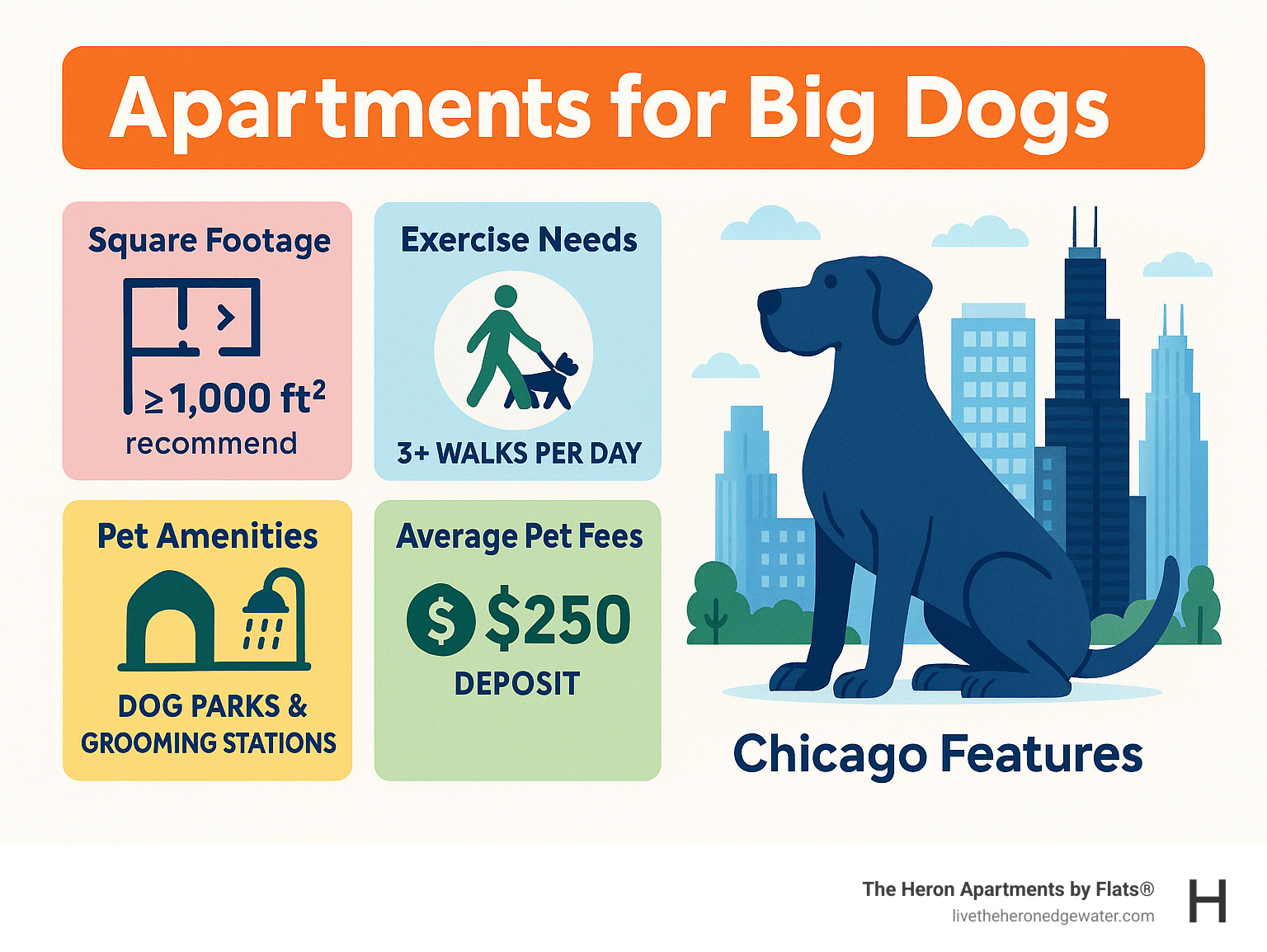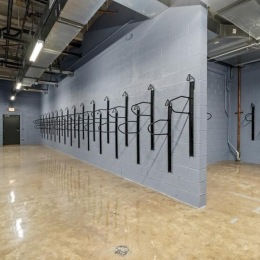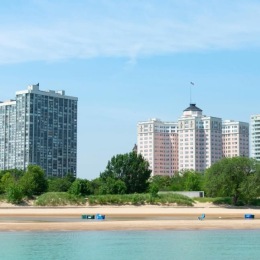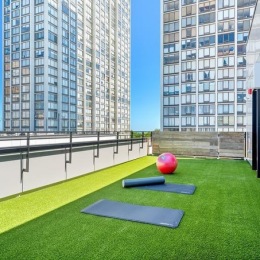Why Chicago Apartments Are Perfect for Your Large Dog
Apartments for big dogs are easier to find in Chicago than you might think. The myth that large breeds need houses with yards is just that - a myth. Many big dogs actually thrive in apartment settings when their needs are properly met.
Quick Guide to Big Dog Apartment Living:
- Best Breeds: Great Danes, Greyhounds, Mastiffs (low energy, calm temperament)
- Exercise Needs: 3 walks per day minimum, plus mental stimulation
- Space Requirements: Quality over quantity - cozy corners beat unused yards
- Key Amenities: Dog parks, pet spas, private patios, nearby trails
- Average Weight Limits: 25-50 pounds (but many buildings are flexible)
Here's the reality: a well-exercised Great Dane will happily nap on your couch for 20 hours a day. Meanwhile, that "apartment-friendly" small dog might bark at every hallway sound and chew your furniture out of boredom.
Chicago's lakefront location gives you miles of trails. The city's dog parks provide social outlets. Modern apartments offer pet amenities that didn't exist five years ago. Plus, about 70% of apartments now welcome pets - and that number keeps growing.
The secret? It's not about the size of your space. It's about matching your dog's temperament to your lifestyle and finding the right building with the right policies.

Why Big Dogs Can Thrive in the Windy City
Chicago breaks every stereotype about big dogs needing suburban backyards. The truth? Many large breeds are practically designed for city living, and Chicago offers the perfect combination of urban conveniences and outdoor access to make it work beautifully.
Here's what most people don't realize: temperament beats size every single time when it comes to apartment living. That gentle Great Dane lounging in your living room is probably happier than a hyperactive terrier bouncing off the walls of a house with a yard.
Sighthounds like Greyhounds and Irish Wolfhounds are famous for being "40-mile-per-hour couch potatoes." They'll sprint for a few minutes, then spend the next 20 hours napping. Guard breeds like Mastiffs and Bullmastiffs were bred for short bursts of protective activity, not marathon running sessions. These gentle giants often have lower energy needs than those "apartment-friendly" medium-sized working dogs that everyone recommends.
The magic happens when you focus on quality over quantity. A tired dog is a well-behaved dog, whether they got tired from a thoughtful 30-minute walk or wandering aimlessly around a backyard for hours.
Chicago's walkable neighborhoods actually create better exercise routines than most suburban yards. You'll naturally walk your dog three times daily - morning, midday, and evening - giving them structure, mental stimulation from new sights and smells, and social interaction with other dogs and people.
Scientific research on mental stimulation proves that puzzle toys, training sessions, and exploring new environments can exhaust your dog's mind just as effectively as physical exercise tires their body. A mentally stimulated big dog becomes a calm, content apartment companion.
Apartments for Big Dogs: Essential Amenities
The best apartments for big dogs in Chicago aren't just pet-tolerant - they're designed with your four-legged family member in mind. Modern buildings understand that happy pets mean happy residents, and they're stepping up with amenities that make apartment living genuinely enjoyable for large breeds.
Private patios or balconies give your dog quick outdoor access without elevator trips for every bathroom break. On-site dog parks provide safe spaces for off-leash play and socialization with neighbor dogs. Pet washing stations are lifesavers after muddy lakefront trips - because let's be honest, washing a 100-pound dog in your bathtub isn't fun for anyone.
At The Heron in Edgewater, we've thought through these details. Our in-unit laundry makes dealing with dog bedding and seasonal shedding much easier. The rooftop lounge welcomes well-behaved dogs to enjoy city views alongside their humans. Our adaptable Ori units maximize space efficiency, giving you and your large dog room to coexist comfortably.
Sound insulation matters more than you might think. Good noise control means fewer complaints about occasional barking and less stress for noise-sensitive breeds. Elevator access saves your dog's joints from daily stair climbing, especially important for giant breeds prone to hip issues.
Some luxury buildings now offer pet concierge services including dog walking, grooming appointments, and pet sitting. Package acceptance becomes essential when you're ordering 40-pound bags of dog food online. Climate-controlled storage gives you space for dog supplies without cluttering your living area.
Apartments for Big Dogs: Exercise Options
Chicago's geography is like winning the lottery for large dog owners. Lake Michigan provides 18 miles of lakefront trail - imagine having that as your daily walking route! The city maintains over 600 parks, including dozens of dedicated dog areas where your pup can socialize and burn energy.
The Lakefront Trail stretches from Hollywood Beach down to 71st Street, offering everything from leisurely strolls to power walks. Montrose Dog Beach lets water-loving breeds swim and play off-leash. Northerly Island provides 91 acres of trails and open space for longer trips.
Technology can help ensure your big dog gets adequate exercise. FitBark trackers monitor daily activity levels, taking the guesswork out of whether your Great Dane has had enough movement. These devices help you establish routines that keep your dog healthy and content.
Professional dog walkers available through various apps can handle midday exercise when work keeps you busy. Doggy daycare services provide socialization and supervised play, especially valuable for high-energy breeds. Training classes offer mental stimulation through obedience work or agility exercises.
The secret sauce is consistency. Large dogs thrive on predictable routines, so establishing regular exercise times helps them settle into apartment life beautifully. A well-exercised big dog becomes the perfect apartment companion - calm, content, and ready to relax at home with you.
Top-Rated Apartments for Big Dogs in Chicago
Finding the perfect home for you and your gentle giant has never been easier in Chicago. The city's rental market has completely transformed over the past few years, with buildings now competing to attract pet owners rather than turning them away.
Apartments for big dogs are popping up across the city, but not all neighborhoods are created equal. Edgewater has emerged as the top choice for large dog owners, and it's easy to see why. The lakefront access means your Saint Bernard can enjoy morning beach walks. The tree-lined streets provide plenty of sniffing opportunities for your curious Great Dane. Plus, the community genuinely welcomes four-legged residents.
The key features that make a building truly big-dog friendly go beyond just allowing pets. You'll want to look for spacious floor plans with at least 700 square feet for giant breeds - your Mastiff needs room to stretch out. Flexible weight limits of 75 pounds or higher (or better yet, no restrictions at all) mean you won't have to fib about your dog's actual size. Breed-neutral policies ensure your sweet pit bull mix won't face discrimination.
Reasonable pet fees matter too, because let's be honest - large dogs already cost enough in food and vet bills. The best buildings charge fair deposits and monthly pet rent that won't break your budget. Easy outdoor access through balconies, patios, or ground-floor units can be a lifesaver during those middle-of-the-night bathroom emergencies.
Edgewater offers something special that downtown high-rises simply can't match. Foster Beach provides off-leash time where your dog can actually run and swim in Lake Michigan. Berger Park hosts dog-friendly community events where your pup can socialize. The Broadway corridor welcomes leashed dogs at outdoor cafes and shops.
Even better, the CTA allows leashed dogs during off-peak hours, so you and your well-behaved companion can explore the entire city together. Try doing that with a car and a 150-pound Newfoundland.
More info about Apartments That Allow Big Dogs
| Feature | Budget-Friendly | Mid-Range Pet Buildings | Premium Pet-Focused |
|---|---|---|---|
| Weight Limit | 25-50 lbs | 75+ lbs | No limit |
| Pet Deposit | Lower range | Mid-range | Higher investment |
| Monthly Pet Rent | Basic fee | Moderate fee | Premium fee |
| Breed Restrictions | Many | Few | None |
| Pet Amenities | Basic | Dog park | Full pet spa |
| Square Footage | 500-800 sq ft | 800-1200 sq ft | 1200+ sq ft |
The investment in a truly pet-friendly building pays dividends in peace of mind. Buildings with proper amenities mean fewer neighbor complaints when your Great Dane's tail accidentally knocks something over. Professional pet washing stations keep your apartment clean after muddy lakefront trips. Sound insulation means your dog's occasional bark won't cause drama.
At The Heron, we've designed our Edgewater location with big dogs in mind. Our adaptable Ori units maximize space efficiency, so even our smaller floor plans feel spacious for large breeds. The rooftop lounge welcomes well-behaved dogs to enjoy stunning lake views alongside their humans. In-unit laundry becomes essential when you're dealing with the shedding schedule of a German Shepherd or the drool situation of a Bernese Mountain Dog.
The bottom line? Chicago's rental market has finally caught up with the reality that responsible pet owners make excellent tenants. Your large dog isn't a liability - they're family. The right building will treat them that way too.
How to Keep Your Large Dog Happy Without a Yard
The absence of a yard doesn't mean your large dog can't live their best life. In fact, many apartment dogs are healthier and better socialized than their suburban counterparts because they get more varied exercise and social interaction.
Indoor Enrichment Strategies:
- Puzzle feeders: Slow down eating while providing mental stimulation
- Interactive toys: Kong toys, snuffle mats, and treat-dispensing balls
- Training sessions: 10-15 minutes of obedience work can tire a dog mentally
- Rotation system: Keep toys interesting by rotating them weekly
- Scent games: Hide treats around the apartment for "hunting" practice
Structured Exercise Schedule:
- Morning walk: 20-30 minutes to start the day
- Midday break: Quick potty walk or professional dog walker
- Evening exercise: Longer walk or dog park visit
- Weekend trips: Extended hikes or beach trips
The quality of exercise matters more than quantity. A 30-minute structured walk with training elements can be more tiring than an hour of aimless wandering in a yard.
Indoor Games for Large Dogs:
- Hide and seek: Great for recall training and mental stimulation
- Tug of war: Builds bond and provides physical exercise
- Find the treat: Develops problem-solving skills
- Stair climbing: Controlled exercise for building strength
- Balance work: Using stability balls or wobble boards
- Nose work: Teaching dogs to identify specific scents
Creating Dedicated Space: Even in small apartments, dogs need their own space. A corner with a comfortable bed, water bowl, and favorite toys gives large dogs a sense of security. Crate training provides a safe retreat when they need downtime.
Socialization Opportunities:
- Dog parks: Regular visits for off-leash play
- Training classes: Group obedience or agility work
- Pet-friendly businesses: Breweries, bookstores, and cafes
- Apartment building: Interactions with neighbors and their pets
The key is routine. Dogs thrive on predictability, so establishing consistent exercise and enrichment schedules helps them adapt to apartment living.
Navigating Pet Policies & Winning Over Landlords
Finding apartments for big dogs often feels like solving a puzzle where the pieces keep changing. Most buildings post weight limits between 25-50 pounds, which seems to rule out your gentle giant entirely. But here's the thing - those restrictions aren't always set in stone.
The real challenge isn't your dog's behavior (you know they're perfect). It's getting past the assumptions landlords make about large breeds. Many property owners have never lived with a Great Dane who naps 20 hours a day or a Mastiff who's afraid of butterflies.
What's Really Behind the Restrictions:
Landlords worry about property damage from scratched hardwood floors and chewed door frames. They fear noise complaints from neighbors who assume big dogs are loud. Liability concerns keep them up at night, imagining worst-case scenarios. Some buildings even face higher insurance costs for certain breeds.
The good news? You can address every single one of these concerns before they become problems.
Start building your case with a pet resume - yes, your dog needs their own professional document. Include recent photos showing your well-groomed, calm companion. Add vaccination records and spay/neuter certificates. If your dog has earned their Canine Good Citizen certification, make that front and center.
Liability insurance is your secret weapon. Pet insurance that covers property damage and potential injuries shows landlords you're serious about responsibility. It costs less than most people's coffee budget but provides massive peace of mind for property owners.
The Fair Housing Act protects service dogs from breed and weight restrictions entirely. Emotional support animals have fewer protections, but legitimate documentation still carries weight in negotiations.
Craft a Winning Application
Your pet application should tell a story - the story of a responsible owner and a well-behaved companion who would be an asset to any building community.
Reference letters make the difference. Your previous landlord confirming no damage or complaints is gold. A veterinarian's letter describing your dog's gentle temperament and excellent health reassures nervous property managers. If you've worked with a professional trainer, their assessment of your dog's behavior can override breed stereotypes.
The meet-and-greet strategy works wonders. Once landlords see your calm, well-trained dog in person, those weight limit concerns often disappear. Bring your dog's favorite blanket and let them demonstrate their "settle" command. A Great Dane lying quietly at your feet is worth a thousand words about their apartment suitability.
Documentation should include current vaccination records, proof of regular veterinary care, and details about your daily exercise routine. Show landlords you understand your dog's needs and have concrete plans to meet them.
Negotiation Hacks for Apartments for Big Dogs
Sometimes "no pets over 50 pounds" really means "convince me this won't be a problem." Smart negotiation can turn a firm policy into a flexible conversation.
Offer a larger security deposit - but make sure it's refundable. This shows good faith while protecting the landlord's interests. Extended lease terms can sweeten the deal, especially in competitive markets where landlords value stability.
Timing your search strategically helps too. Late fall and winter typically have less competition, giving you more negotiating power. Month-end searches catch landlords eager to fill vacant units before the next billing cycle.
Single-family rentals often offer more flexibility than large apartment complexes. Individual property owners can make decisions without corporate policies getting in the way. Real estate brokers familiar with pet-friendly properties know which landlords are open to negotiation and which buildings regularly approve large dogs.
Professional services demonstrate your commitment to responsible ownership. Mention your relationship with local dog walkers, groomers, and veterinarians. This network shows landlords you're invested in your pet's wellbeing and the community.
The key is presenting yourself as the kind of tenant any landlord would want - responsible, prepared, and proactive about potential concerns. Your big dog isn't a liability; they're part of a package deal with an excellent tenant.
Frequently Asked Questions about Apartments for Big Dogs
Are large breeds really suitable for Chicago apartments?
Here's the surprising truth: many large breeds make better apartment neighbors than their smaller, more energetic counterparts. Great Danes, often called "gentle giants," typically sleep 18-20 hours per day. Greyhounds, despite their racing reputation, are famous couch potatoes who need just short bursts of exercise.
The secret lies in understanding temperament over size. A calm, well-trained Mastiff will quietly nap in the corner while a bored Jack Russell might bark at every footstep in the hallway. Large breeds like Saint Bernards and Newfoundlands were actually bred to be calm, steady companions - perfect qualities for apartment living.
What really matters is matching your dog's personality to your lifestyle. Low-energy giant breeds often adapt beautifully to apartment routines. They're content with structured walks and indoor relaxation time. Plus, their size often makes them naturally gentle and less likely to engage in destructive behaviors.
The key is owner commitment. Large dogs need consistent exercise, mental stimulation, and proper training regardless of living space. When these needs are met, many apartment-dwelling big dogs are actually happier and better socialized than their suburban counterparts who spend long hours alone in yards.
How much daily exercise does a big dog need without a yard?
The magic number for most large breeds is three structured outings per day - but quality beats quantity every time. A focused 30-minute walk with training elements can tire your dog more effectively than an hour of aimless yard wandering.
Morning walks should be 20-30 minutes to help your dog start the day calmly. Midday breaks can be shorter potty walks, especially if you use professional dog walking services. Evening exercise is your main event - longer walks, dog park visits, or lakefront trips.
Different breeds have surprisingly different needs. Great Danes need just 1-2 moderate walks daily and actually shouldn't over-exercise due to their size. Greyhounds love short sprints but are content with brief walks otherwise. Standard Poodles need more varied activities to keep their intelligent minds engaged.
Mental stimulation is equally important. Puzzle feeders, training sessions, and interactive toys can exhaust your dog's brain as effectively as physical exercise tires their body. A tired mind equals a calm apartment companion.
Chicago's lakefront location is a huge advantage here. The 18-mile Lakefront Trail provides endless variety for walks, and the city's numerous dog parks offer socialization opportunities that suburban yards simply can't match.
What if my lease has a strict weight limit?
Weight limits aren't always set in stone - they're often starting points for negotiation. Many landlords will bend rules for responsible pet parents who demonstrate their dog's excellent behavior and their own commitment to property care.
Start by building your case with documentation. A professional pet resume including training certificates, veterinary records, and reference letters from previous landlords can work wonders. Photos of your well-groomed, calm dog help landlords see past breed stereotypes.
Financial incentives often open doors. Offering a larger security deposit shows you're confident in your dog's behavior. Comprehensive pet liability insurance protects the landlord's interests. Some tenants even offer slightly higher monthly rent in exchange for pet approval.
Consider alternative housing types if traditional apartments prove inflexible. Individual condo owners often have more flexibility than corporate landlords. Single-family home rentals frequently welcome larger dogs. Some newer apartment communities are moving away from weight restrictions entirely, focusing instead on pet interviews and behavior assessments.
Professional help can make a difference too. Real estate brokers who specialize in pet-friendly housing know which landlords are genuinely flexible and which weight limits are truly non-negotiable. They can save you time and improve your success rate significantly.
The rental market is competitive for landlords too. Properties that welcome well-behaved large dogs often attract responsible, long-term tenants - exactly what property owners want.
Conclusion
The idea that big dogs can't be happy in apartments is one of those myths that just won't go away. But here's the truth: apartments for big dogs in Chicago aren't just possible - they're often better than suburban living with a yard.
Think about it. Your Great Dane gets three structured walks along Lake Michigan instead of wandering around the same backyard. Your Mastiff meets new dogs at the local dog park instead of barking at the fence. Your Greyhound enjoys climate-controlled comfort instead of being left outside in Chicago's unpredictable weather.
Size really doesn't determine happiness. Temperament does. Energy level does. But square footage? Not so much. A calm, well-exercised giant breed can thrive in a thoughtfully chosen apartment, especially when that apartment comes with modern amenities designed for pet owners.
Chicago makes it work because the city accepts dog ownership. The lakefront trails provide endless walking routes. The neighborhood dog parks offer socialization opportunities. Professional dog walkers and daycare services fill in the gaps when life gets busy.
The key is finding the right building with the right policies. Buildings like The Heron in Edgewater understand that pet ownership isn't just a hobby - it's a lifestyle. Our adaptable Ori units maximize every square foot, while our pet-friendly amenities support both you and your four-legged family member.
Building community matters too. When you're a responsible pet owner in an apartment building, you're not just keeping your dog happy - you're showing neighbors and landlords that big dogs can be wonderful apartment residents. Every well-behaved apartment dog makes it easier for the next family to find housing.
The rental market has shifted dramatically in favor of pet owners. Landlords who once said "absolutely no pets" are now competing for responsible pet owners with specialized amenities. Weight limits that seemed set in stone are becoming more flexible. Breed restrictions are giving way to individual assessments.
Your success comes down to matching your dog's needs with your commitment level. If you can provide consistent exercise, mental stimulation, and proper training, your large breed can absolutely thrive in Chicago apartment living. The structured routine often makes them happier and healthier than their suburban counterparts.
More info about Dog Friendly Apartments Chicago IL
At the end of the day, your big dog doesn't need a yard to be happy. They need you to be committed to their wellbeing. They need consistent exercise and mental challenges. They need a comfortable space to call home. Chicago's apartments for big dogs can provide all of that - often better than a house with a yard ever could.










